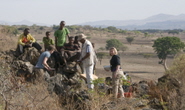Developments in geophysical methods used to monitor surface and subsurface changes prior to landslides can lead to improved prediction and early warning.
Why is the monitoring of landslides important, and what role can geophysics play?
Sometimes the most effective option for mitigating the risk from landslides is monitoring.
In an ideal world, we would have the geotechnical and financial resources to be able to remove all landslide hazards through slope stabilization and remediation. In reality, this just isn’t possible, and sometimes the most effective option for mitigating the risk from a landslide is to monitor it.
What are the different types of landslides and why are geophysical methods particularly useful for monitoring “moisture-induced” landslides?
“Landslide” is one of those words that sounds simple enough to define but in reality is very complex.
One of the distinctions we can make between landslide types is their triggering mechanism; most landslides are caused by the direct consequences of increased rainfall and shaking by earthquakes, but they can also be a result of secondary factors such as deforestation.
Between 2007 and 2016, 83% of landslides globally were triggered by rainfall or other hydrological events. This is why we use the term “moisture-induced” in our review article, as it reflects the complicated nature of all sources of water present in landslide systems, including rainfall, snow-melt, and groundwater, amongst others.
What different geophysical methods are used to gather information about moisture-induced landslides?
The majority of studies used passive seismic and active geoelectrical methods.
Our review article looks at published case studies from the past 12 years to see what kinds of methods are being applied to monitor moisture-induced landslides. What struck us was that the majority of studies used one of two methods: passive seismic and active geoelectrical methods.
Passive seismic monitoring has been used for many decades in global seismological studies, but really only started to be scaled down to look at smaller scale features, such as landslides, in the mid-1990s.
What do these methods tell us about the subsurface conditions of landslides?
The two approaches provide an opportunity to better understand the variable nature of the subsurface in time and space.
Passive seismic and active geoelectrical approaches complement each other very well. First, they tell us about different aspects of the subsurface conditions beneath a landslide. Seismic methods are able to tell us about the strength of the ground, while ER methods provide information about subsurface moisture dynamics. Both of these aspects are very important when trying to predict landslide movements.
Second, passive approaches tend to have great temporal resolution, but their spatial coverage can be limited by the number of seismic sensors deployed on a slope, usually due to cost or power requirements. On the other hand, ER methods can provide very high spatial resolution, but as they are dependent on collecting a set of data from many measurements, their temporal resolution can be limited. Together, the two approaches provide an opportunity to better understand the variable nature of the subsurface in time and space.
What advances in equipment and data analysis have improved understanding of landslide processes?
The financial, computational, and energy cost of equipment is continually reducing, which means we can collect more data for longer periods, and send data from the field to the lab for near real-time analysis.
Recently, there has been an increase in the use of 3D surveys and petrophysical relationships linking geophysical The financial, computational and energy cost of equipment is continually reducing, which means we can collect more data for longer periods. Also, data telemetry means we can send data from the field to the lab for near real-time analysis. Both of these are crucial when using geophysical methods for early-warning of landslide failure.
In ER monitoring, movements in the electrode array would have historically produced errors in the resistivity model, but developments in ER data inversion can now use this source of “error” to track movements in the landslide. Similarly seismic “ambient noise” is being used in innovative ways to monitor landslides, even though these background signals would have traditionally been undesirable in seismological surveys.
Left: The “Automated time-Lapse Electrical Resistivity” (ALERT) geoelectrical monitoring system installed at Hollin Hill, North Yorkshire, UK. Right: Inside the cabinet, the system acquires geoelectrical, geotechnical and weather data. Collecting geophysical measurements alongside local displacement and environmental data allows for more robust interpretations of the changes in subsurface geoelectrical data over time. Credit: British Geological Survey
Where is the field of geophysical monitoring of moisture-induced landslide heading?
The challenge now is to start looking for clues to identify precursory conditions to slope failure and to develop geophysical thresholds to inform early-warning approaches.
The great news is that this is a very active area of research! There is a lot of work being done in environmental seismology to increase the number of low-cost, low-power seismic sensors that can be deployed in landslide settings. This is important, as it will allow us to monitor landslides at very high-resolution in both the spatial and temporal domain.
———————————
This blog was written by Cabot Institute for the Environment member James Whitely, postgraduate researcher at University of Bristol’s School of Earth Science and the British Geological Society, with contributions from the articles co-authors. The blog was originally published by Editors’ Vox.
Original blog Citation: Whiteley, J. (2019), Downhill all the way: monitoring landslides using geophysics, Eos, 100 https://doi.org/10.1029/2019EO111065



















